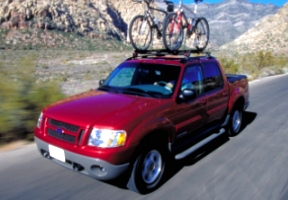
This Week:
© 1998
- 2000 Copyright &
Disclaimer
Automotive Intelligence,
www.autointell.com
All Rights Reserved .
For questions please contact
editor@autointell.com

News of February 8, 2000
.
| Louisville builds new Ford Explorer Sport
Trac . |
|
| LOUISVILLE - The 2001-model Explorer Sport Trac, the newest
addition to Ford Motor Company's sport utility lineup, was officially launched here today
by the men and women who build it. "We've got a lot to celebrate," said Louisville Assembly Plant (LAP) Manager John Tankesley. |
Explorer Sport Trac Photo: Ford |
| "In addition to Explorer Sport Trac, more
than 3,400 employees here build the best-selling four-door Ford Explorer, the two-door
Explorer Sport and the Mercury Mountaineer." As of January 31, Ford had received more than 20,000 dealer orders for the new Explorer Sport Trac. "And we're the only plant producing Explorer Sport Trac," added UAW Local 862 Building Chairman Don Mitchell. "Explorer Sport Trac is not an ordinary vehicle. It combines the benefits of the four-door Explorer with the added usefulness of an open cargo area." The four-foot-long cargo area is made of durable sheet molding composite. It features an optional device that extends the length of the cargo area as well as an optional, lockable hard tonneau cover. Prices for the 2001-model Explorer Sport Trac will range from $23,050 (for the 4X2 model) to $25,820 (for the 4X4 model), including destination and delivery. As the name implies, Explorer Sport Trac is the sportiest member of the Explorer family -- catering to customers who are young, active, independent-minded and looking for more fun and adventure than he or she can find in a car. Ford Explorer has been a runaway sales success since its debut in 1990. As America's best-selling sport utility vehicle for nine straight years, it has changed the face of the sport utility vehicle market. In 1999, 428,000 Explorers were sold in the United States. Since its introduction, more than 3.3 million U.S. customers have purchased an Explorer. Ford Explorers also are built at the company's St. Louis Assembly Plant in Hazelwood, Missouri. Louisville employees were the first to build four-door Ford Explorers when the vehicles were launched. To date, Louisville employees have built more than 2.9 million Explorers. LAP employees also built best-selling Ford Ranger pickup trucks until April 1, 1999, when they ceased production to free up capacity for the Explorer Sport Trac. (LAP's Ranger production was split between Ford's Ranger plants in Twin Cities, MN and Edison, NJ.) During Ranger production, LAP ran two body shops - one dedicated to producing boxes for the Ranger. "The departure of Ford Ranger from Louisville allowed the plant to replace its two body shops with a new, larger and more efficient single operation," said Tankesley. The new body shop was installed virtually parallel with the old one, ramping up as the current-model line continued to run at full speed. "Because LAP is large enough to accommodate what amounts to two body shops, we were able to install the plant's new body shop without interrupting production of Explorers and Mountaineers," said Tankesley. The new enlarged body shop also is very flexible, allowing the plant to quickly alter the mix of vehicles. Customer wants can be rapidly satisfied. If customers order more Sport Tracs, for example, the body shop can run more of those models without upsetting the "rhythm" of the factory. This is possible because all of the models have common locating or "hard" points. "The Explorer Sport Trac, Explorer Sport and four-door Explorer share a common body shop, paint, trim, chassis and final assembly line," according to Explorer Sport Trac Chief Program Engineer Steve Ross. "This gives us the flexibility to meet whatever mix of models the market demands." Ross, who ordinarily resides in Michigan, has been on site in Louisville working with assembly plant employees as well as engineers to help assure a smooth manufacturing launch. All major body panels, except the roof, on the Explorer Sport Trac are made of two-sided galvanized steel. The Sport Trac's frame receives a new, full immersion, electro coated, corrosion-resistant primer for even better rust protection. To ensure that paint on the Sport Trac's body and rustproof box match perfectly, the outer composite plastic panels of the box are kept together on steel skids before being sent with the steel body through the paint shop and oven. The painted box panels then meet up with the inner plastic tub of Sport Trac's composite cargo area. Employees then attach the painted outer panels, tailgate, cargo PowerPoint and a host of other dressings before the completed cargo area is attached to the Explorer Sport Trac's frame. (Feb. 3, 2000) |
|
[Homepage]
[ News] [ Companies] [ Management] [ Publications] [ Events] [ Careers]
[Services] [Discussion] [ Guestbook] [ Search]
